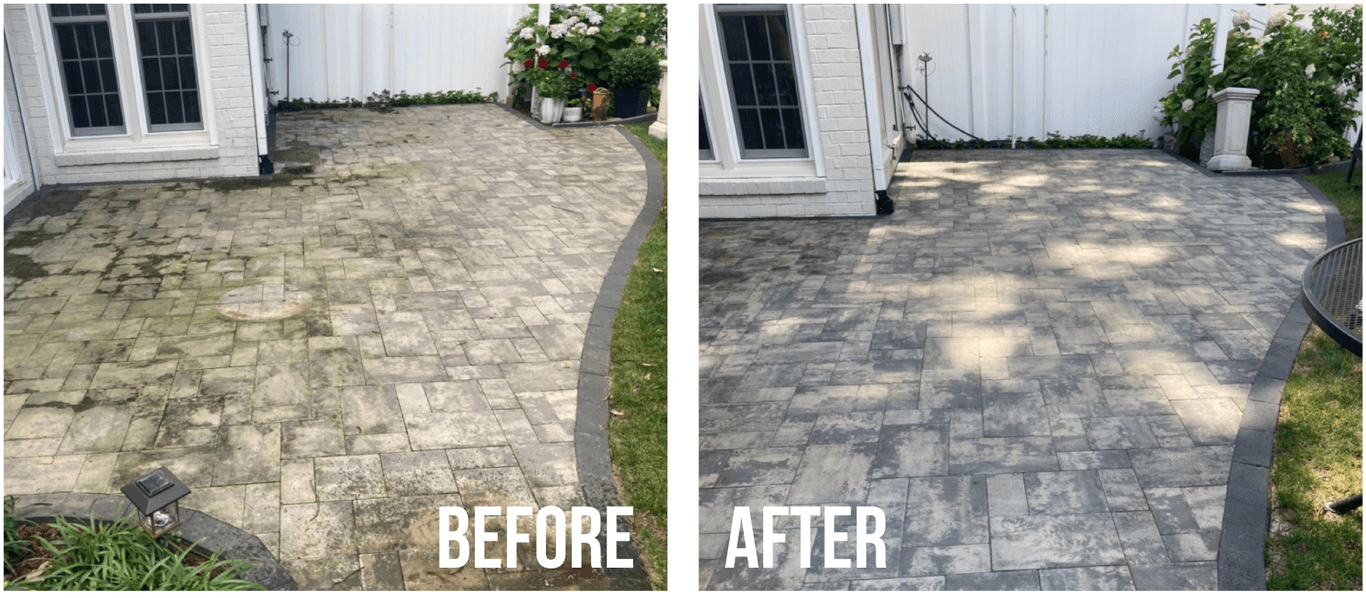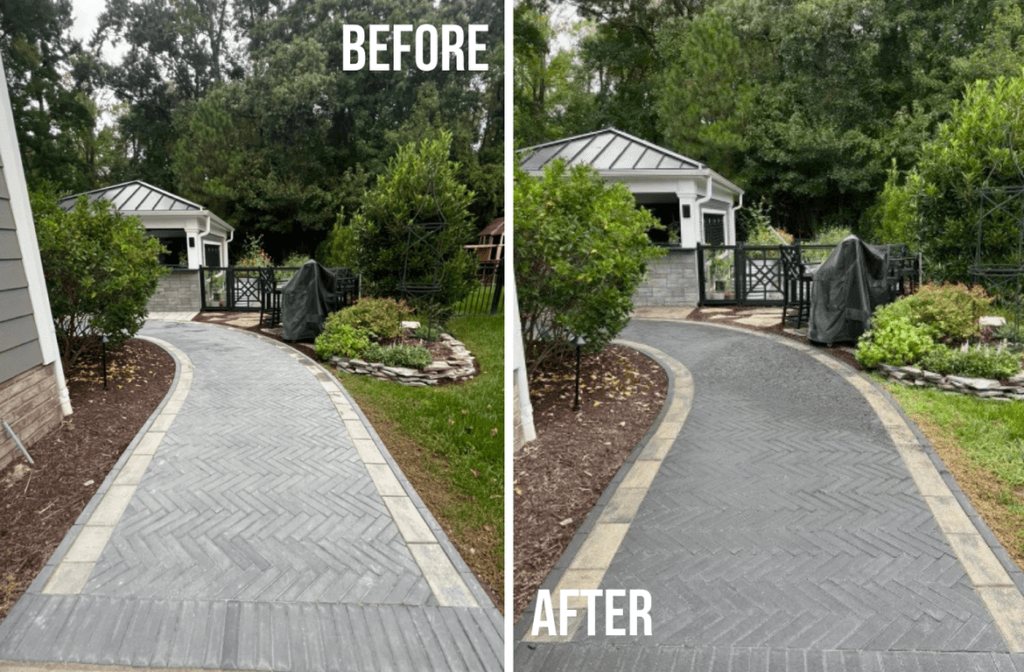
02 Dec Paver Maintenance: Everything You Need to Know
Imagine stepping outside to enjoy your patio—your private oasis—and being met with cracked joints, stained pavers, or even pesky weeds creeping in where they don’t belong. Maybe it’s been a few years since your patio was installed, or perhaps you just inherited it when you bought your home. Either way, you’re starting to notice that it doesn’t look quite as fresh as it once did, and the thought of maintaining it feels overwhelming.
You might wonder: Is it too late to fix? Will sealing help, or is it just a waste of money? What about those stains—are they here to stay?
At Easton Outdoors, we’ve seen it all—from patios that just need a little TLC to those that feel like they’re on their last leg. The good news? There’s a solution to just about every problem. This Q&A guide is here to give you straightforward answers to your biggest questions about paver maintenance. No jargon, no fluff—just clear, honest advice from a team that’s as invested in your patio as you are.
Ready to get started?
What Is Paver Maintenance and Why Is It Important?
Before diving in, let’s tackle the first question you probably have – is paver maintenance actually that important? Pavers are like the unsung heroes of your outdoor space. They take a beating from rain, sun, and foot traffic day after day, but they also set the stage for countless memories—from cookouts to quiet mornings with coffee.
Paver maintenance is how you protect that investment. It’s about more than just keeping things pretty (although that’s a nice bonus). Regular cleaning, sealing, and joint repair can extend the life of your patio, prevent costly repairs down the road, and make it easier to enjoy your space without worrying about cracks, weeds, or discoloration.
Now, let’s take a look at the questions below to help you determine exactly what kind of maintenance your patio requires.

1. How Long Ago Was Your Patio Installed?
Time matters when it comes to paver maintenance.
- If it’s been less than a year, your patio probably just needs a light cleaning and maybe some sealing to keep it protected. Think of it like waxing a new car—it’s not essential yet, but it’ll save you headaches later.
- If it’s been 1–3 years, you’re likely starting to see some wear. Joint sand might need a touch-up, and stains could start to show if the patio hasn’t been sealed.
- If it’s been 3+ years, it’s probably time for a full refresh. Sand could be missing altogether, and stains or organic growth might have settled in. This is where cleaning, joint restoration, and sealing can work wonders.
2. What Type of Patio Do You Have?
This question isn’t just for curiosity—it helps us figure out the best care plan.
- Pavers or permeable pavers: These are our specialty. We know exactly how to clean, seal, and restore them to keep your patio looking its best.
- Stamped concrete: Unfortunately, this isn’t a service we currently offer.
If you’re not sure exactly what you have, don’t sweat it. We can help you figure it out during your consultation.
3. What Type of Sealer Should You Choose?
Sealing your patio protects it from stains, fading, and general wear and tear—but not all sealers are created equal. Here’s a quick breakdown:
- Penetrating, invisible sealers: Great for a natural look, but they need to be reapplied every year.
- Satin finish: Adds a subtle sheen and lasts about 1–2 years.
- Wet look: Our go-to recommendation. It’s the most durable, lasting up to 3 years, and it gives your patio a rich, polished finish.
4. What Condition is Your Joint Sand In?
Joint sand does more than just hold your pavers in place—it keeps weeds out and helps with water drainage. Here’s how to tell what your patio needs:
- Nonexistent sand: If your joints are empty, it’s time for a full clean and new sand installation.
- Needs a bit of touch-up: We can fill in gaps and make it look like new.
- Great condition: If the sand is solid, a simple clean and seal is probably all you need.
5. Does Your Patio Have Major Stains?
Not all stains are created equal, and some need extra attention:
- Mold and leaf stains: These can often be cleaned, but there’s a chance the joints might discolor. If you’re looking for perfection, joint removal might be the best option.
- Oil or heavy residue: These require specialized cleaning and may add extra cost, but they’re not impossible to tackle.
6. Does Your Patio Need Any Repairs?
Over time, patios can start to show signs of wear and tear. Uneven areas, sinking pavers, or other issues can happen due to natural settling, heavy foot traffic, or even weather changes. If you’re wondering whether your patio might need repairs, here’s how we approach it:
- Yes, We Have Quite a Few Uneven Areas: If your patio has multiple uneven spots, it’s likely more than just a cosmetic issue. These areas can create tripping hazards and allow water to pool, which may lead to further damage over time. This type of repair typically ranges from $1,000–$3,000 depending on the extent of the work needed.
- Yes, Just a Couple of Minor Adjustments: Small fixes, like a few pavers sitting slightly out of place, are usually quicker and less expensive to handle. Most minor repairs fall in the $500–$1,000 range.
- No, It’s in Great Shape: If your patio doesn’t need repairs, that’s great news! A good cleaning and sealing can keep it in tip-top condition, preventing potential issues from developing later.
7. Has Your Patio Been Previously Sealed?
Knowing your patio’s history helps us choose the right approach:
- Yes, but I don’t know the details: We may need to strip the old sealer, especially if it was polyurethane-based. This costs an additional $2 per square foot but ensures a clean slate for new sealing.
- Yes, and I know the type of sealer: Perfect! We can work with that information to find the best solution.
- No, this is a virgin patio: No extra prep needed—just a clean, seal, and you’re good to go.
8. Is There Organic Growth in the Joints?
Weeds or moss in the joints can be more than just an eyesore—they might signal deeper issues with the sand. If growth is limited to the edges, it’s usually a quick fix. If it’s throughout the patio, we’ll inspect to make sure the sand hasn’t been compromised.
9. How Often Do You Want to Seal Your Patio?
The lifespan of your sealer depends on your preferences and patio use:
- One year: Ideal for homeowners who want a regular maintenance routine.
- Two years: A solid middle ground that balances durability and cost.
- Three years: Best for those looking for long-term protection. We recommend a high-performance 2-part urethane wet look sealer which provides the best color enhancement, stabilization, and surface protection.
Paver Maintenance Service FAQ's
What if it rains on my scheduled maintenance day?
We keep a close eye on the weather, but Mother Nature doesn’t always cooperate. If rain is in the forecast, we’ll reschedule to ensure the best results.
Can my pets walk on the patio after sealing?
Unfortunately, no. It’s crucial to keep pets (and people!) off the patio for at least 24 hours to allow the sealer to cure properly.
Do I need to move my furniture?
We’ve got you covered—literally. We’ll handle moving your furniture, but we ask that you bring in any cushions beforehand.
What about weeds or organic growth?
If your patio has significant growth, we’ll ask you to spray a weed killer like Roundup beforehand. We’re not licensed to apply it ourselves.

